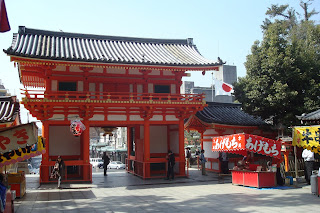Part 2
Part 3
Part 4
Part 5
For its fame and accessibility (it's like ten minutes on foot from Sanjou-Shijou), 八坂神社 Yasaka Jinja is one of those things that you sort of have to see if you come to Kyouto. Yasaka-san, as older people affectionately call it, is not as spectacular or exciting as some of the city's other attractions, but the exhibitionism generally gets reserved for the temples anyway. Which seems strange, doesn't it, considering that the latter is a place for adherents to practice asceticism and restraint, whereas the former is a home for the gods themselves. Anyway, Yasaka Jinja is a nice little place, a convenient meeting spot, and popular for hatsumode, among other things.
Here we are a few steps back from the shot that closed out Part 1.
From time to time they set up a bunch of food stalls selling staples like mochi and takoyaki, creating a festival kind of atmosphere. I used to think I just had impeccable timing, but actually it happens with startling regularity.
If you read Japanese, I heartily recommend creeping these things. They paint all the hopes, pain, and humour of life, compressed to the size of a small wooden panel. It's like the Twitter of prayer.
Just to the right, you can get your fortune read.
This, of course, is the main reason you'll have come: Throw in some money (a 5-yen coin, if you've got one) and ask for good luck on your shuukatsu or konkatsu or whatever.
There's the south gate, which leads to some other interesting parts of Gion, though I would recommend you actually leave by the east gate if you plan on walking south. The streets you'll end up taking are a little more interesting.
On the north side, meanwhile, you can find some bits and pieces like this. If you, like me, can spend hours thoroughly exploring a shrine or temple, it's mildly worth strolling through. Otherwise no.
This gate leads to a park in the northeast, which is also worth a miss. When I say the word "park," what do you envision? If you said "a field of dust," congratulations, you live in Japan.
A famous baseball player from the mid-20th Century, if I had to guess, which I don't.
All right, let's wander back. South gate...
...east gate.
What the hell?
Oh, got it.
It's an anti-nuclear protest. Nuclear power is a question of much debate among the Japanese populace in light of Fukushima, but this protest was actually against nuclear weapons. I don't know if this was a perfunctory event or if some politician suggested that maybe they should consider discussing the possibility that Japan possessing nukes might be beneficial in some way. Either way, it's fitting that they would choose the location of this particular sakura tree, a Kyouto symbol of peace, as their site.
Here it is lit up during hanami season.
Live music washed throughout the area. I'd say that most Japanese people agree with the sentiment these people were expressing, though they would not share their enthusiasm or, judging by this photo, their lifestyle.
There's a weird little modern art outdoor exhibit on top of a hill behind this whole area. Make of it what you will.
Past even that, we arrive at this statue. It's certainly striking; who is this guy to have earned such immortalization? Why, it's cultural hero Sakamoto Ryouma! Kneeling beside him is his retainer, Nakaoka Shintarou, who was also killed when Sakamoto was assassinated. At the time, Sakamoto was beloved and esteemed as a visionary, and indeed he was quite ahead of his time intellectually, so his death was met with shock and dismay. Though the Mimawarigumi eventually confessed to the crime, it was initially believed that the Shinsengumi were responsible, which led to the group's swift downfall thereafter. Well, that and the fact that the government they served was overthrown, but yeah.





























No comments:
Post a Comment